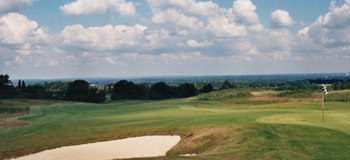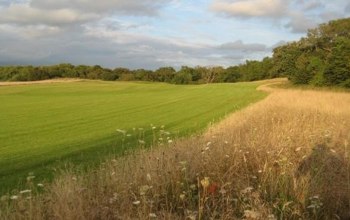Feature review - Clandon Golf Club
The Course

Clandon Golf Club, located conveniently close to Guildford Town Centre, is a new pay-and-play golf club that has only had a fully operational 18-hole golf course for less than a year. In honesty, this is something that is immediately apparent as you drive into the car park, where a Portakabin poses under the guise of a professional shop and absolutely no practice facilities come into view. As the old adage says, however, ‘don’t judge a book by its cover’; a thought that every golfer must retain as they arrive at Clandon Golf Club.
With uncertain economic times, it seems a wise move to hold fire on a clubhouse and practice facilities. It is incredibly difficult to start a business with the economic climate as it is, and to its great credit, Clandon Golf seems to be succeeding. Even on a freezing February afternoon, the course was filled with golfers, something that must be predominantly attributed to the cost of play. As always, though, the success of a new golf club depends on more than economics, and the course is far better than you would infer from the Portakabin welcoming you on arrival. Some of the holes are beautifully crafted and on a good day, the views of the Surrey hills are something to behold.
My Experience
The golf course has been built on chalky soil, which can often account for a bare lie. On the other hand, drainage is good, and you tend to avoid those soggy lies that can so often cause you to hit the ball fat. The course is relatively short, and the front nine probably presents the best opportunity for low scoring. In truth, there are also plenty of chances on a back nine where an enormous quarry comes into play.
The first hole is straightforward par-4 and the second a downhill par-3. The third hole is again short, but you need to find the right hand side of the fairway to avoid two sizeable trees that guard the approach to the green.
The fourth hole is one of the only holes where you can find trouble off the tee. A bush row on the right of the fairway and two bunkers in the fairway place a premium on accuracy from the tee. The approach is played to an uphill green that is difficult to hold.
The fifth, again, is a straightforward par-4, but trouble lurks behind the green if you are overzealous with your approach.
 The par-5 sixth is arguably the best hole on the course. Out of bounds lurks down the right hand side, and the ideal position to play your second shot from is the left hand side of the fairway. The second shot, often with a long iron, is a daunting prospect: push it right, and you will find bushes, go left and the same scenario awaits. To add to the difficulty of the second, a tree is placed inconsiderably in the middle of the fairway, just before the hole turns 90 degrees right. If you have cleared all the obstacles after your second, you are still faced with a significantly downhill approach to a narrow green that is guarded by bunkers on the right hand side. A par is a fantastic score on this hole.
The par-5 sixth is arguably the best hole on the course. Out of bounds lurks down the right hand side, and the ideal position to play your second shot from is the left hand side of the fairway. The second shot, often with a long iron, is a daunting prospect: push it right, and you will find bushes, go left and the same scenario awaits. To add to the difficulty of the second, a tree is placed inconsiderably in the middle of the fairway, just before the hole turns 90 degrees right. If you have cleared all the obstacles after your second, you are still faced with a significantly downhill approach to a narrow green that is guarded by bunkers on the right hand side. A par is a fantastic score on this hole.
Seven is tricky par-3, demanding a well struck iron shot to clear the large bunker protecting the front of the green.
The eighth is an average length, downhill then uphill par-4 followed by the long par-4 ninth, which precedes the easy par-4 tenth. Find the sizeable fairway (shared with the 18th) and you should make par.
Eleven plays as the longest par-4, and is an uphill, dogleg left. Pull your drive and you will find the longest rough on the course, push your drive and you be left with an approach of at least 200 yards. Bunkers and heavy rough shield a green that is very difficult to hold.
Twelve is a nondescript par-3 before the best three holes on the golf course come into play. Thirteen is a wonderful par-5. The tee shot is downhill to a wide fairway, but long rough lurks on both sides of a fairway that really should be found from the tee. The second shot is perilous. A valley of vegetation protects the green which sits 50 yards above the fairway, and any lay-up to a narrow area on the left of the valley must be hit solidly. From there, a wedge is required to find a green that resembles an upturned bowl. Any shot that lands on the green will go through the back and may find bushes, and any shot that is pushed could end up in the same valley that causes so much difficulty with the second.
Fourteen is a severely downhill par-3 with a quarry on the left of the green and bunkers on the right. Judging the elevation is the key to success, and even though it is only 150 yards long, par is a very good score.
The hardest drive on the course is to be found on the fifteenth hole. You drive over an enormous quarry that will consume any golf ball hit badly, hit too far left or too far right. Even if you find the fairway, the second shot is tremendously difficult. The green is about 50 yards below the level of the fairway, and you must hit a draw with a long iron to find a green that is angled from right to left.
The last three holes provide an opportunity for a good end to the round. Sixteen is an average length par-3 and seventeen a short, downhill par-4 that can be driven with a good drive that misses the quarry on the right hand side of the fairway. Eighteen shares its fairway with the 10th hole, and even with an average drive your approach won’t be much longer than 150 yards to a large green guarded by a solitary bunker.
Ranking
As previously expressed, the course is new and as such, any ranking must take potential into consideration. The greens aren’t in the best condition, many holes will be forgotten in a heartbeat and only a few present a real challenge. Having said that, it is excellent value for money, the constant stream of golfers should provide funds for future investment, and thirteen thru fifteen is arguably the most entertaining stretch of holes that I have played. I would give Clandon Golf and overall ranking of 3/5, but this rating could well have improved a year or two down the line.
Related Content:

















